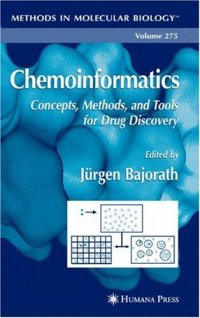
Ebook: Chemoinformatics: Concepts, Methods, and Tools for Drug Discovery
- Genre: Chemistry
- Tags: Pharmacy
- Series: Methods in Molecular Biology 275
- Year: 2004
- Publisher: Humana Press
- Edition: 1
- Language: English
- pdf
In the post-genomic era, the role informatics technologies plays in chemical and pharmaceutical research has become increasingly important in data management and lead-compound identification. In Chemoinformatics: Concepts, Methods, and Tools for Drug Discovery, well-recognized pioneers and investigators from diverse professional environments survey the key concepts in the field, describe cutting-edge methods, and provide exemplary pharmaceutical applications. The authors explain the theory behind the crucial concepts of molecular similarity and diversity, describe the challenging efforts to use chemoinformatics approaches to virtual and high-throughput screening, and illuminate the latest developments in multidimensional QSAR analysis. Other topics of interest include the use of partitioning algorithms and classification methods for analyzing large compound databases, screening sets, and virtual screening for active molecules; different approaches to target class-specific library design; the generation of novel classes of molecular descriptors; and Web-based tools for chemical database access and management. Also presented are different methods for describing molecular chirality and conformational parameters and for predicting the drug-like character and basic ADME properties of compounds based on modeling their putative interactions with cytochrome P450 isoforms.
State-of-the-art and user-friendly, Chemoinformatics: Concepts, Methods, and Tools for Drug Discovery illuminates the conceptual and methodological diversity of this rapidly evolving field and offers instructive examples of cutting-edge applications in the drug discovery process.
Univ. of Washington, Seattle. Offers a survey of key concepts, novel methods, and applications of chemoinformatics. Discusses the theory behind the concepts of molecular similarity and diversity and offers different methods for describing molecular chirality and conformational parameters. For researchers.